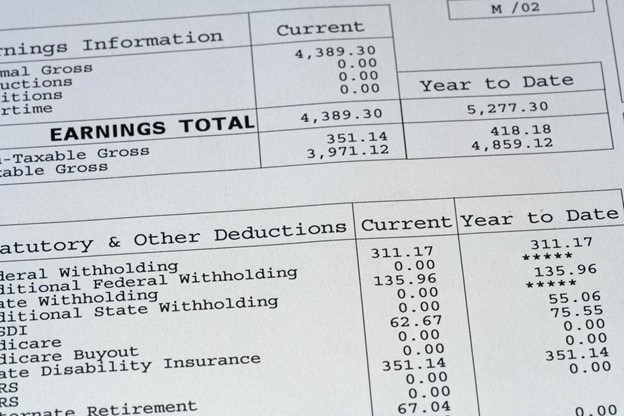How to Deal With the Payroll Process On Your Own

Handling payroll on your own can feel like a daunting task. This is especially true when balancing a business or freelancing with managing your finances. However, understanding the payroll process is crucial for business owners, freelancers, and contractors. It helps business owners and freelancers comply with tax laws and pay employees or contractors accurately and on time.
Many businesses outsource payroll to specialized services. However, learning to manage it independently can save costs and give you more control over your financial processes. Whether paying employees with a Form W-2 or independent contractors with a Form 1099-NEC, understanding the payroll process is key. Staying on top of your tax obligations ensures smooth and compliant operations.
This guide will walk you through the essential steps for managing payroll on your own. You’ll learn everything from payroll basics to staying organized and compliant with tax regulations. Let’s dive in and make this process easier to tackle.
Understanding the Basics of Payroll
Before you dive into processing payroll, it’s important to familiarize yourself with some fundamental payroll concepts. Whether you’re managing payroll for employees or independent contractors, understanding these basics will help you navigate the process with confidence. This knowledge will also help you avoid costly mistakes.
Key Payroll Terms:
1) Gross Pay: This is the total amount earned by an employee before any deductions or taxes are taken out. It includes hourly wages, salary, bonuses, and overtime pay.
2) Net Pay: Net pay is the amount employees actually take home. It’s calculated after all deductions, such as taxes and other withholdings, are subtracted from their gross pay.
3) Deductions: These are amounts taken out of an employee’s gross pay. They can include:
- Federal income tax: The amount withheld based on the employee’s W-4 form.
- State and local taxes: These vary by location and depend on where the employee works.
- Social Security and Medicare (FICA taxes): These are mandatory federal taxes that fund the Social Security and Medicare programs.
- Other deductions: Health insurance, retirement contributions, union dues, etc.
4) Employer Contributions: As an employer, you may be responsible for paying certain taxes and contributions. These are paid on behalf of your employees. These include:
- Employer’s portion of FICA taxes: The employer must match the employee’s Social Security and Medicare contributions.
- Unemployment taxes (FUTA and SUTA): These are federal and state unemployment taxes. They help provide benefits to workers who lose their jobs.
Employee vs. Independent Contractor:
It’s crucial to know the distinction between employees and independent contractors. This distinction impacts both the payroll process and tax filings.
- Employees (Form W-2): If you’re paying someone as an employee, they are subject to payroll taxes. You must withhold federal and state income taxes, as well as Social Security and Medicare contributions. At the end of the year, you’ll issue them a Form W-2 to report their wages and taxes withheld.
- Independent Contractors (Form 1099-NEC): Independent contractors are not subject to the same payroll tax withholding. Instead, they are responsible for paying their own taxes, including self-employment tax. If you pay an independent contractor $600 or more during the year, you must issue them a Form 1099-NEC. This form reports the payments made.
Understanding these basic payroll concepts will set you up for success when it comes time to calculate wages, make deductions, and stay compliant with tax regulations.
Collecting and Organizing Payroll Information

Properly organizing and collecting the necessary payroll information is the foundation for a smooth payroll process. Whether you’re paying employees or independent contractors, gathering accurate data from the outset will save you time and prevent errors later on. Here’s how to ensure you have everything you need….
-1- Employee/Contractor Information:
For employees, you’ll need the following:
- W-4 Form: When hiring an employee, they must complete a Form W-4, which determines their federal income tax withholding based on their filing status and any allowances they claim. Keeping this form up to date is essential for ensuring the correct amount of taxes are withheld.
- I-9 Form: You’ll also need to verify an employee’s eligibility to work in the U.S. by collecting information through the Form I-9.
For independent contractors, you’ll need:
- W-9 Form: Before making payments to a contractor, you should have them fill out Form W-9, which provides you with their taxpayer identification number (TIN) and other details necessary for tax reporting.
-2- Time Tracking:
For employees who are paid hourly, it’s essential to track their time accurately. This can be done manually or through timekeeping software. Make sure to record:
- Total hours worked
- Overtime hours (if applicable)
For salaried employees, the timekeeping requirement may be less frequent, but you’ll still need to ensure that any paid time off (PTO), sick leave, or vacation days are accounted for. Independent contractors typically don’t require time tracking, but you’ll want to keep a record of the amount you’ve paid them and any agreements regarding payment schedules or rates.
-3- Pay Rates:
It’s crucial to have up-to-date pay rate information for each employee or contractor. This includes:
- Hourly rate or annual salary for employees
- Pay rate or project fees for contractors
- Any bonuses, commissions, or overtime pay
Having this information organized allows you to calculate payroll accurately and avoid underpaying or overpaying your employees or contractors.
-4- Payroll Software or Tools:
While some businesses opt to handle payroll manually, using payroll software or tools can save you time and help you avoid errors. These tools can help with:
- Calculating wages based on hours worked or salary
- Withholding the correct amount for taxes and deductions
- Generating paystubs and records for both employees and contractors
- Filing taxes and forms like Form W-2 and Form 1099-NEC
At FormPros, we are the premier online tax-form generation company, offering a streamlined payroll solution that includes the ability to generate and file tax forms like Form W-2 for employees and Form 1099-NEC for contractors. Choosing FormPros for your payroll process ensures that your forms are accurate, timely, and compliant with tax regulations, making your payroll process easier and more efficient.
By gathering the right information and utilizing the right tools, you’ll be well-equipped to move on to the next step: calculating payroll.
Calculating Payroll
Once you’ve gathered all the necessary information and set up your payroll system, it’s time to calculate the actual pay for your employees and contractors. Whether you’re paying an hourly wage, a salary, or a project fee, it’s important to ensure accuracy to avoid overpaying or underpaying your workers.
1) Calculating Gross Pay –
The first step in calculating payroll is determining the gross pay, which is the total amount an employee or contractor has earned before any deductions are made.
- For hourly employees: Multiply the number of hours worked by the hourly rate. If they worked overtime, make sure to calculate it based on the overtime pay rate (usually 1.5 times the regular hourly rate).
- For salaried employees: Divide the annual salary by the number of pay periods in the year. For example, if they are paid bi-weekly, divide the salary by 26.
- For independent contractors: Use the agreed-upon rate or project fee to determine how much they should be paid. If it’s based on hours worked, track those hours as you would for an hourly employee.
2) Applying Deductions –
Once you’ve calculated gross pay, the next step is to subtract various deductions. These may include:
- Federal income tax: Based on the employee’s Form W-4 and their filing status, you’ll withhold federal income tax. Payroll software can help calculate this accurately based on current tax brackets.
- State and local income taxes: In addition to federal income tax, you may need to withhold state and local taxes, which vary depending on the employee’s location.
- FICA taxes (Social Security and Medicare): You must withhold Social Security and Medicare taxes from the employee’s gross pay. For 2025, the employee pays 6.2% for Social Security (up to a wage base limit) and 1.45% for Medicare. The employer also matches these amounts, so you’ll need to contribute as well.
- Other deductions: These can include health insurance premiums, retirement contributions, garnishments, and any other voluntary or required deductions.
3) Calculating Net Pay –
Once all deductions have been subtracted from the gross pay, the result is the net pay — the amount the employee or contractor takes home. This is the final amount that you will pay out to the worker.
For contractors, since they are responsible for their own tax filings, you won’t withhold taxes on their pay. However, you will still need to report the total amount paid to them using Form 1099-NEC at the end of the year if their total earnings exceed $600.
Making Payments and Filing Payroll Taxes

Once you’ve calculated payroll, the next step is to pay your employees and contractors while ensuring you stay compliant with tax requirements.
Paying Employees
— The most common methods for paying employees include direct deposit, paper checks, and payroll cards. Direct deposit is the fastest and most secure, allowing employees to access their funds immediately. Paper checks, though less common, are still used by some businesses, while payroll cards offer an alternative for employees without bank accounts. Whatever method you choose, providing employees with pay stubs detailing gross pay, deductions, and net pay is essential for transparency.
Paying Independent Contractors
— For independent contractors, payments are typically made through bank transfers, checks, or online services like PayPal. Unlike employees, contractors are responsible for their own tax filings, but it’s important to track payments accurately and issue them a Form 1099-NEC at the end of the year for any amount paid over $600.
Filing Payroll Taxes
— Filing payroll taxes involves submitting federal, state, and local income taxes, as well as Social Security and Medicare contributions (FICA). Employers must remit these taxes to the IRS and the appropriate state authorities, using forms such as Form 941 for quarterly filings. Additionally, unemployment taxes (FUTA and SUTA) need to be submitted to help provide benefits for unemployed workers.
Wrapping Up Your Payroll Process
Managing payroll on your own can seem overwhelming at first, but by following these key steps, you can streamline the process and ensure that you remain compliant with tax laws. From understanding the basics of payroll and gathering the necessary information, to making payments and filing taxes correctly, staying organized is crucial to keeping everything running smoothly.
By setting up reminders, maintaining thorough records, and regularly reviewing your payroll system, you can avoid errors and penalties. And, with the help of payroll software like FormPros, you can simplify the process, generate tax forms like Form W-2 and Form 1099-NEC, and stay on top of your obligations with ease.
With the right tools and processes in place, handling payroll on your own becomes a manageable task that keeps your business compliant and your workers paid on time.
FormPros Has You Covered
Simplify your paperwork with FormPros! From our paystub generator, W-4s, and 1099-NEC forms to creating LLC Operating Agreements and even voided checks, our easy-to-use platform has you covered. Save time, reduce errors, and handle your business documents with confidence. Start now and see how FormPros makes professional form generation fast, affordable, and hassle-free!
How to Deal With the Payroll Process On Your Own FAQs
-
Do I need an EIN and state payroll accounts before I can run payroll myself?
Yes. Get an Employer Identification Number (EIN) and, in most states, set up separate state withholding and unemployment (SUTA) accounts. Report new hires within your state’s required window (often 20 days). Complete these registrations before your first pay run to avoid penalties.
-
Which pay schedule should I choose—weekly, bi-weekly, semi-monthly, or monthly?
Choose a pay schedule that aligns with both your cash flow and compliance needs. Weekly or bi-weekly schedules simplify overtime calculations, while semi-monthly schedules make it easier to handle benefits deductions. Monthly pay reduces administrative work, but some states prohibit it for non-exempt employees. Always check your state’s rules on minimum pay frequency and overtime requirements before deciding.
-
How do I handle payroll for remote or multi-state employees?
Pay unemployment taxes in the state where your employee performs the work. Some states impose additional local or city taxes, or have reciprocity agreements that alter tax withholding rules. If you hire workers in multiple states, register for payroll tax accounts in each applicable state.
-
What should I do if I make a payroll mistake (under/overpayment or missed overtime)?
Fix payroll mistakes as soon as possible—ideally on the next scheduled payroll or through an off-cycle payment if necessary. Issue a corrected paystub and document the change for your records. If the error affects tax filings, submit an amended return, such as Form 941-X. Also, send a corrected year-end form—like a W-2c or an updated 1099-NEC—if needed.
-
How do wage garnishments and other court-ordered deductions work?
Follow the priority outlined in the garnishment notice—for example, child support takes precedence over tax levies and creditor garnishments. Comply with federal and state limits on how much you can withhold. Always act on garnishment orders promptly: enter them into your payroll system and keep all related documents on file.
-
What payroll records do I need to keep—and for how long?
Store payroll and tax records for several years to stay compliant and audit-ready. As a general guideline, keep payroll and tax documents for at least 4 years. Retain timecards and records of pay rate changes for 2–3 years. For Form I-9, hold onto it for 3 years after the hire date or 1 year after termination—whichever comes later. In heavily regulated industries, consider keeping records even longer.
-
What’s on a year-end DIY-payroll checklist?
- Reconcile totals
- Confirm employee addresses/SSNs and contractor TINs
- Collect W-9s
- Match quarterly 941s to annual W-3
- Prepare and deliver W-2s and 1099-NEC (generally due Jan 31st)
- E-file copies with the IRS/SSA/state as required
- Archive paystubs and reports



























